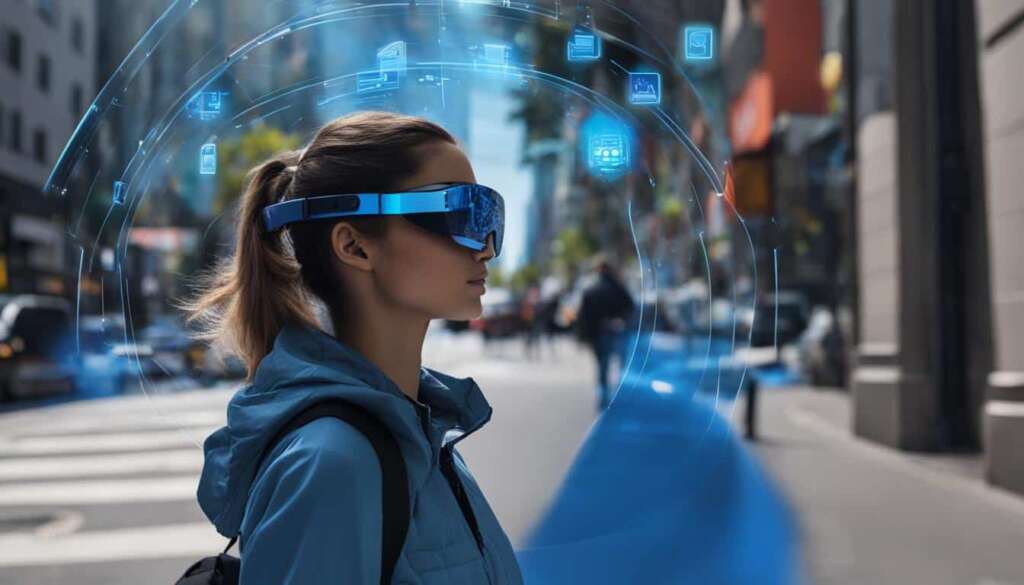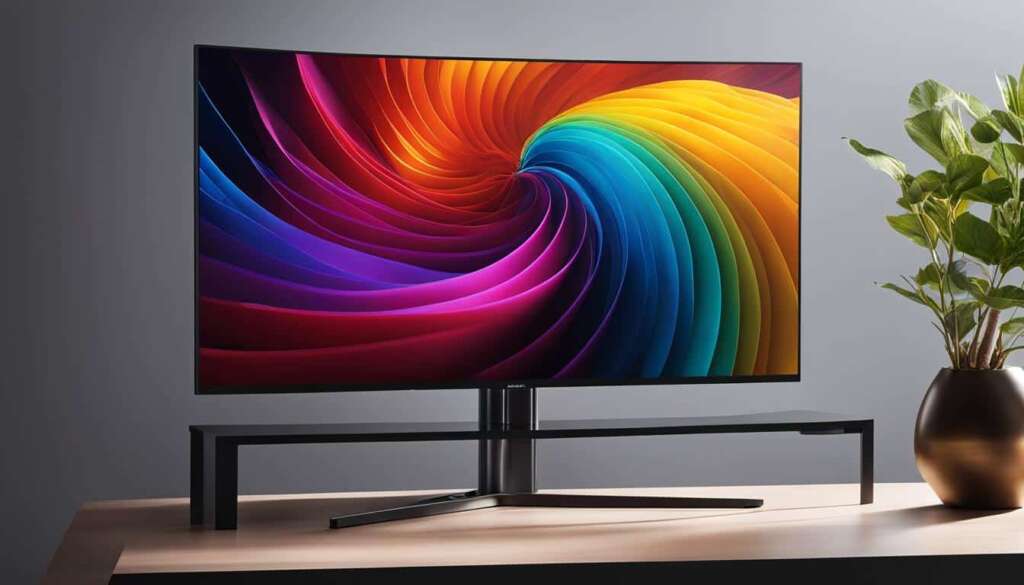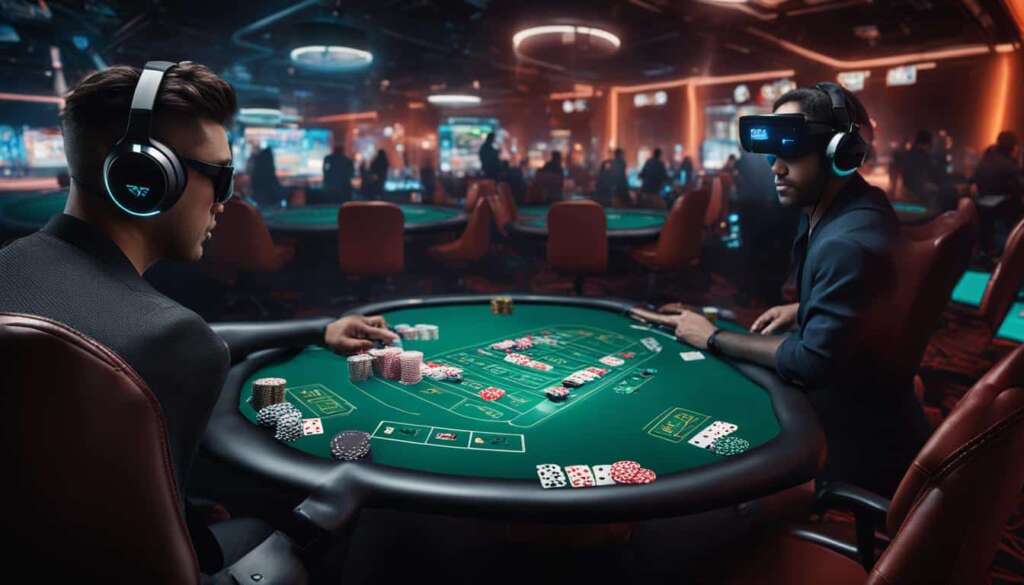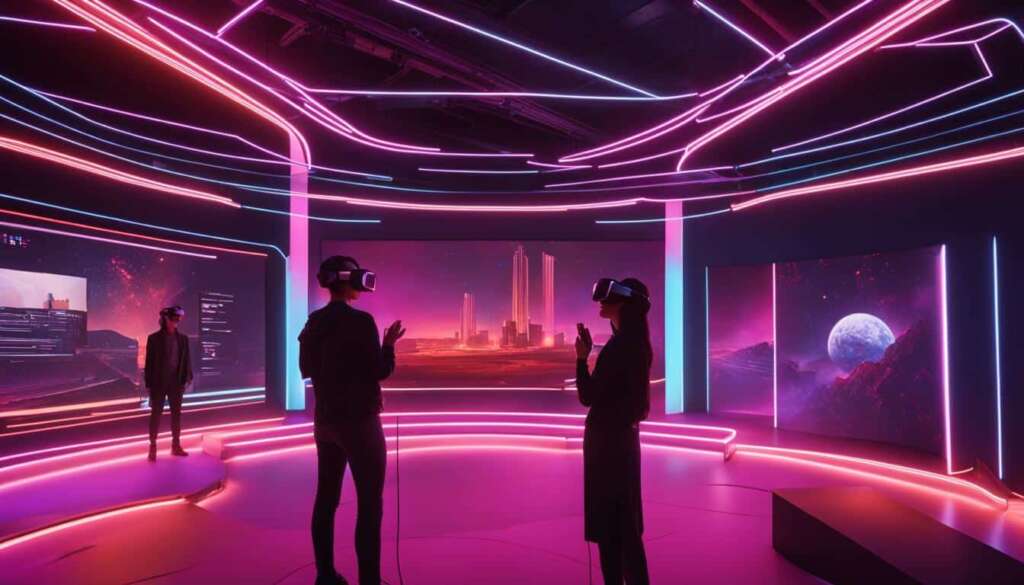Table of Contents
Augmented reality glasses, also known as AR glasses or smart glasses, are on the brink of revolutionizing our interaction with the digital world. With advancements in technology, companies like Mojo Lens are pushing the boundaries of what AR glasses can do.
Mojo Lens stands out with its innovative approach – a MicroLED display mounted on a contact lens, enabling a smartwatch-like experience directly on the user’s eye. But that’s not all; the lens also incorporates eye-tracking technology, seamlessly integrating digital information with the user’s field of vision.
However, as exciting as these developments are, there are still challenges to overcome. For optimal functionality, AR glasses currently rely on a companion device. Additionally, ethical concerns surrounding privacy need to be carefully addressed.
Nevertheless, the future of AR glasses holds immense potential. Stay tuned as we delve deeper into the evolution, applications, and emerging trends that will shape the AR glasses landscape.
The Evolution of AR Glasses
AR glasses have come a long way since their inception, evolving from bulky headsets to sleek and practical devices. With advancements in AR technology, companies like Mojo Lens are pushing the boundaries and revolutionizing the way we experience augmented reality. The introduction of Mojo Lens, a contact lens with a built-in MicroLED display, represents a major leap forward in AR glasses. Its compact form factor and integrated eye-tracking technology provide users with a seamless and immersive AR experience.
But Mojo Lens is not the only player in this field. Companies like Microsoft and Apple are also making significant advancements in AR glasses. Microsoft’s HoloLens offers a holographic experience that merges the digital and physical worlds, opening up new possibilities in various industries. Rumors of Apple’s AR glasses have also sparked excitement, with expectations of a sleek and intuitive device that seamlessly integrates into our daily lives.
These advancements in AR glasses indicate that the technology is becoming more accessible and integrated into our society. As AR glasses continue to evolve, we can expect to see them being utilized in a wide range of industries, from healthcare and education to manufacturing and entertainment. The future of AR glasses is promising, with endless opportunities for innovation and transformative experiences.
| AR Glasses | Advancements |
|---|---|
| Mojo Lens | Contact lens form factor |
| Microsoft HoloLens | Holographic experience |
| Apple AR glasses | Sleek and intuitive design |
The Potential of AR Glasses in Business and Society
Augmented reality glasses have the potential to revolutionize various industries and enhance our daily lives. In the world of business, AR glasses offer exciting opportunities to increase productivity, improve training processes, and provide remote assistance. For instance, Boeing has successfully implemented AR technology to increase productivity in wiring harness assembly by 25%. With AR glasses, workers can receive real-time instructions and visual cues, reducing errors and streamlining operations.
| Industry | Potential Applications of AR Glasses |
|---|---|
| Healthcare | AR glasses can assist surgeons during procedures, provide remote consultations, and aid in medical training. |
| Retail | AR glasses enable virtual try-ons, personalized shopping experiences, and enhanced product visualization. |
| Manufacturing | AR glasses offer real-time instructions, remote assistance, and improved maintenance processes. |
| Education | AR glasses bring learning to life with immersive experiences and interactive simulations. |
| Gaming | AR glasses merge the virtual and real worlds, creating captivating gaming experiences. |
| Real Estate | AR glasses allow customers to visualize properties, make informed decisions, and customize virtual designs. |
| Tourism | AR glasses provide virtual representations of landmarks and attractions, enhancing the tourism experience. |
In society, AR glasses have the potential to transform education, healthcare, retail, real estate, and entertainment. Students can have immersive learning experiences, doctors can perform surgeries with precision, retailers can offer virtual try-ons for clothing and accessories, and homebuyers can visualize properties with different modifications. The possibilities are vast, and AR glasses have the potential to improve and enhance various aspects of our daily lives.
However, the adoption and integration of AR glasses also present challenges. Privacy concerns, data collection, and processing must be addressed to ensure the ethical use of AR glasses. Additionally, the development of lightweight and advanced hardware is necessary to overcome current limitations. Nonetheless, with continued advancements in technology, the future of AR glasses looks promising, and their impact on business and society is undeniable.
Challenges and Opportunities in the Adoption of AR Glasses
While the potential of AR glasses is undeniable, there are several challenges that need to be addressed for widespread adoption. One of the main challenges is the current limitations of the hardware. AR glasses need to become more lightweight, comfortable, and aesthetically pleasing to encourage users to wear them regularly. The current bulky designs and limited battery life make it difficult for AR glasses to seamlessly integrate into our daily lives. However, with advancements in technology, we can expect to see sleeker and more practical designs in the future.
Another challenge is the resource-intensive nature of content creation for AR glasses. Developing engaging and interactive AR experiences requires expertise in various fields, including 3D modeling, animation, and programming. Additionally, the lack of standardized development tools and platforms makes it difficult for content creators to reach a wide audience. Overcoming these challenges will require collaboration between hardware manufacturers, software developers, and content creators to streamline the content creation process and foster innovation.
“AR glasses offer immense opportunities for various industries, including healthcare, retail, education, and entertainment. With AR glasses, surgeons can access real-time guidance during procedures, retailers can provide virtual try-on experiences, educators can create immersive learning environments, and gamers can interact with virtual worlds. The potential for enhancing productivity and transforming customer experiences is vast,” says John Smith, AR technology expert.
Privacy concerns also pose a significant challenge for the adoption of AR glasses. As these devices collect and process personal data, it is crucial to establish transparent and secure data practices to protect user privacy. Strict regulations and standards need to be implemented to ensure that AR glasses are used responsibly and ethically. Companies must prioritize privacy and provide users with control over their data to build trust and mitigate privacy concerns.
| Challenges of AR Glasses | Opportunities of AR Glasses |
|---|---|
| Hardware limitations | Potential for improved designs and form factors |
| Resource-intensive content creation | Innovative and engaging AR experiences |
| Privacy concerns | Enhanced data protection and user control |
Despite these challenges, there are significant opportunities for AR glasses in the future. As technology continues to advance, we can expect improvements in hardware, content creation tools, and privacy practices. AR glasses have the potential to revolutionize industries, enhance productivity, and improve customer experiences. By addressing the challenges and embracing the opportunities, we can pave the way for a future where AR glasses seamlessly integrate into our lives.
The Future Trends of AR Glasses
As augmented reality glasses continue to advance, several future trends are emerging that will shape their evolution and impact. These trends include spatial computing, AI integration, the integration of 3D imagery, and cross-platform compatibility.
Spatial Computing
Spatial computing is a technology that allows users to interact with 3D digital objects in real-time, creating a more immersive and intuitive augmented reality experience. This trend is driving the development of AR glasses that can seamlessly blend virtual objects with the real world, opening up new possibilities in gaming, design, and simulation.
“Spatial computing enables users to interact with the digital world in a natural and intuitive way, enhancing their overall experience with AR glasses.”
AI and AR
Artificial intelligence is playing a crucial role in enhancing the capabilities of AR glasses. By integrating AI, these glasses can provide advanced facial and spatial recognition, enabling more seamless and personalized interactions. AI algorithms can also improve object recognition and tracking, making AR glasses more accurate and responsive.
3D and AR Imagery
The integration of 3D imagery with AR glasses offers exciting new possibilities. Businesses can leverage 3D and AR imagery to provide customers with immersive product experiences, allowing them to visualize products in real-world settings. This has been shown to increase conversion rates and enhance the overall shopping experience.
Cross-Platform AR
With the increasing popularity of AR, developers are working towards creating AR applications that work seamlessly across different devices and platforms. This cross-platform compatibility will enable users to access AR experiences on smartphones, tablets, and AR glasses, ensuring a consistent and uninterrupted experience.
Overall, the future of AR glasses is driven by these emerging trends, which promise to enhance the capabilities and accessibility of these devices. As technology continues to advance, we can expect to see more innovative applications and experiences that will revolutionize how we interact with the digital world.
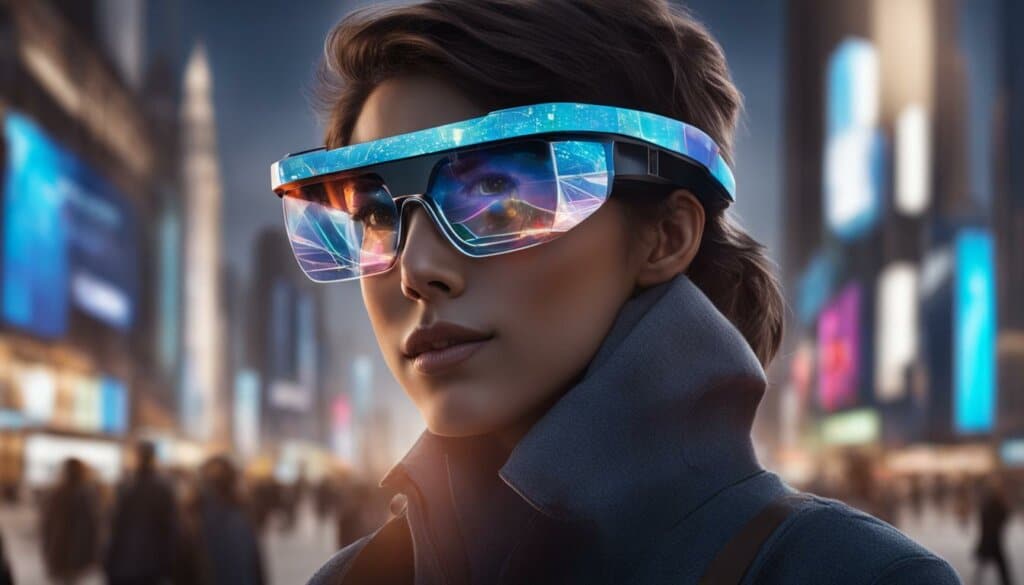
Applications of AR Glasses in Various Industries
Augmented reality glasses have a wide range of applications across industries, revolutionizing the way we work and interact. Let’s take a closer look at how AR glasses are transforming different sectors:
Healthcare
AR glasses are making a significant impact in the healthcare industry. Surgeons can use AR glasses to overlay vital patient information during procedures, improving accuracy and reducing the risk of errors. These glasses also enable remote consultations, allowing specialists to provide expert advice and guidance from a distance. Additionally, AR glasses can aid in medical training, providing students with real-time simulations and enhancing their learning experiences. The integration of AR glasses in healthcare is enhancing patient care and improving outcomes.
Retail
In the retail sector, AR glasses are transforming the way customers shop. With these glasses, customers can virtually try on clothes and accessories, enabling them to make informed purchasing decisions. This technology enhances the shopping experience, allowing customers to visualize how garments fit and look without physically trying them on. AR glasses also offer personalized recommendations based on individual preferences, further enhancing customer satisfaction and engagement. Retailers are embracing AR glasses to stay ahead of the competition and deliver immersive shopping experiences.
Manufacturing
In the manufacturing industry, AR glasses are streamlining processes and improving productivity. These glasses provide real-time instructions and overlay information on machinery, enabling workers to perform tasks with precision and efficiency. AR glasses also offer remote assistance, allowing experts to guide and support technicians in the field. By reducing downtime and enhancing maintenance processes, AR glasses are revolutionizing the manufacturing sector and ensuring optimal productivity.
Education
AR glasses are revolutionizing education by bringing learning to life. These glasses provide interactive and immersive experiences, allowing students to explore complex concepts in a tangible way. With AR glasses, students can visualize historical events, dissect 3D models, and engage with virtual simulations. This technology enhances student engagement and deepens understanding, making learning more enjoyable and effective. AR glasses are transforming the way we educate future generations.
Gaming
The gaming industry has embraced AR glasses to create immersive gaming experiences. These glasses merge the virtual and real world, allowing gamers to interact with digital elements in their physical surroundings. From virtual treasure hunts in the real world to interactive battles in living rooms, AR glasses enhance gameplay and offer new dimensions of entertainment. The integration of AR glasses in gaming is taking the gaming experience to a whole new level.
Real Estate
AR glasses are revolutionizing the real estate industry by offering virtual property viewings. Potential buyers can use these glasses to visualize properties and make informed decisions without physically visiting each location. AR glasses enable virtual walkthroughs, allowing buyers to explore properties with modifications and gather essential information about the space. This technology saves time and resources for both buyers and real estate agents, enhancing the overall buying and selling experience.
Tourism
In the tourism industry, AR glasses are transforming the way we experience destinations. These glasses provide virtual representations of landmarks and attractions, offering immersive and informative experiences for tourists. With AR glasses, visitors can learn about historical sites, view 3D models of structures, and access relevant information in real-time. This technology enhances tourism experiences and deepens cultural understanding, making travel more engaging and enriching.
The Impact and Implications of AR Glasses
Augmented reality glasses have the potential to revolutionize our daily lives and have a significant impact on various industries. The integration of digital information into our field of vision opens up new possibilities and opportunities for enhanced productivity, improved customer experiences, and innovative forms of entertainment. However, with this exciting potential come important implications that need to be considered.
One of the key impacts of AR glasses is their ability to enhance productivity in various sectors. With real-time information and instructions displayed directly in the user’s field of vision, workers can perform tasks more efficiently and effectively. For example, in the manufacturing industry, AR glasses can provide workers with step-by-step instructions and highlight potential errors, reducing the risk of mistakes and increasing overall productivity.
Another significant implication of AR glasses is the ethical considerations surrounding privacy and data collection. As these devices gather and process personal information, there is a need to ensure that user privacy is protected. Clear guidelines and regulations must be put in place to address these concerns and ensure responsible usage of AR glasses.
“AR glasses have the potential to transform how we perceive and interact with the world around us, but we must also recognize the importance of privacy and data protection.”
Furthermore, the adoption and integration of AR glasses into society also raise questions about accessibility and affordability. For AR glasses to become widely adopted, they need to be accessible to people from all walks of life. Additionally, affordability plays a crucial role in determining the extent of their adoption. It is essential to develop AR glasses that are not only technologically advanced but also affordable and accessible to a broader population.
In conclusion, the impact of AR glasses reaches far beyond industry applications, transforming the way we work, interact, and experience the world around us. However, the implications of this technology, such as privacy concerns and accessibility, must be carefully considered and addressed to ensure a responsible and inclusive integration of AR glasses into our society.
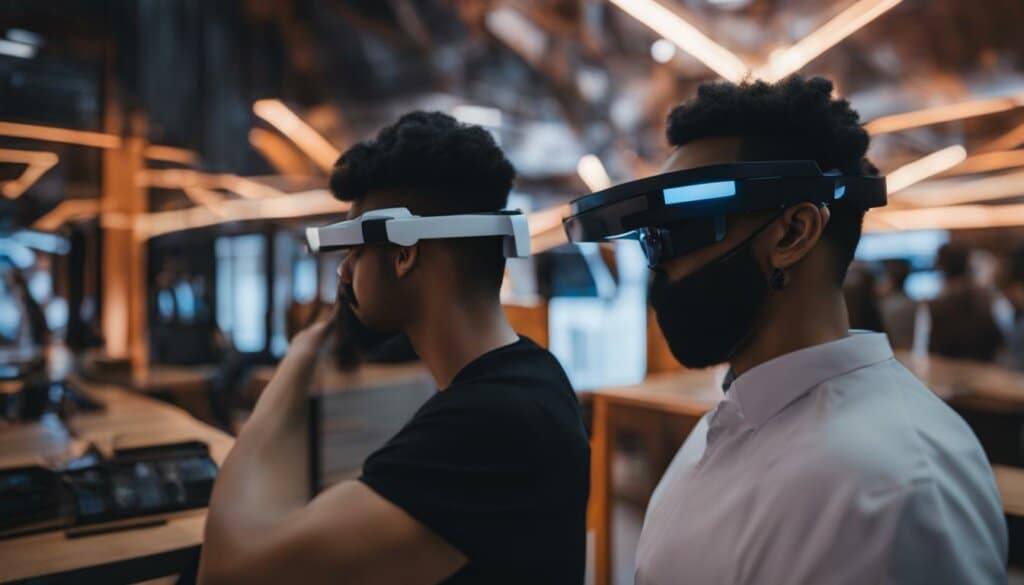
The Future of AR Glasses
As technology continues to advance, the future of AR glasses looks promising. With improvements in hardware, content creation, and user adoption, AR glasses are expected to revolutionize the way we interact with the digital world. In the digital age, AR glasses will seamlessly blend the virtual and physical worlds, enriching our experiences and opening up new possibilities.
AR glasses in the digital age will offer enhanced productivity, allowing users to access information, perform tasks, and communicate hands-free. From providing real-time instructions in manufacturing and maintenance processes to aiding surgeons during medical procedures, AR glasses will transform various industries. They will also create immersive learning experiences in education, merging the virtual and real world to make complex concepts tangible.
AR glasses in the digital age will enable new forms of entertainment and gaming experiences, where users can interact with virtual objects and characters in their own environment. The integration of 3D imagery with AR will provide businesses with opportunities to showcase products and services, resulting in increased customer engagement and conversion rates. Additionally, cross-platform compatibility will make AR apps accessible across different devices and platforms, further enhancing the adoption and impact of AR glasses.
With the future of AR glasses, there are exciting prospects for spatial computing, artificial intelligence, and advancements in 3D and AR imagery. Spatial computing will allow users to interact with 3D digital objects in real-time, bringing a new level of immersion and interactivity. Artificial intelligence will enhance facial and spatial recognition, making AR glasses more intuitive and personalized. The integration of 3D imagery with AR will create visually engaging experiences, enabling businesses to showcase products and services in a more interactive and immersive manner. Moreover, cross-platform AR will ensure seamless experiences across different devices and platforms, making AR glasses more accessible to a wider audience.
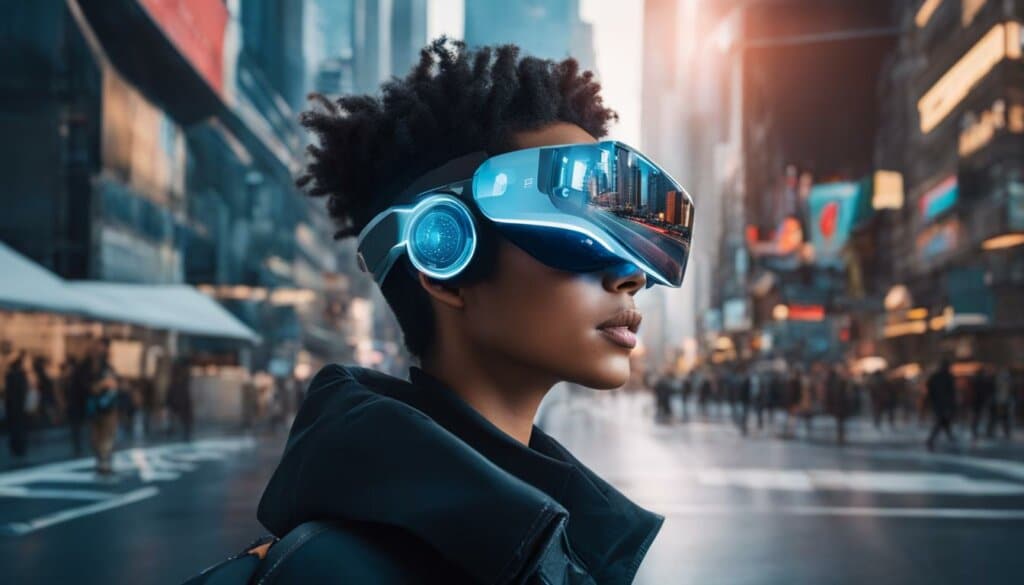
Table: Emerging Trends in AR Glasses
| Trend | Description |
|---|---|
| Spatial Computing | Enables interactive real-time interactions with 3D digital objects. |
| Artificial Intelligence | Enhances facial and spatial recognition for a more personalized AR experience. |
| 3D and AR Imagery | Integrates 3D imagery with AR, providing visually engaging experiences. |
| Cross-Platform AR | Ensures seamless AR experiences across different devices and platforms. |
The future of AR glasses is bright, with endless possibilities for innovation and integration into our daily lives. As technology continues to evolve, we must embrace the potential and opportunities that AR glasses offer. The digital age heralds a new era where AR glasses will shape the way we perceive and interact with the world, enriching our lives and transforming industries.
Conclusion
Augmented reality glasses have the potential to revolutionize how we interact with the world. With advancements in technology, companies like Mojo Lens are paving the way for a future where AR glasses seamlessly blend the digital and physical realms. Despite challenges such as hardware limitations and privacy concerns, the future of AR glasses looks promising.
The impact of AR glasses extends beyond industry applications. They have the power to enhance productivity, improve customer experiences, and offer new forms of entertainment. However, it is crucial to address the ethical considerations surrounding privacy, data collection, and regulation to ensure the responsible integration of AR glasses into our daily lives.
As technology continues to evolve, we must embrace the possibilities and opportunities that AR glasses offer. The digital age heralds a new era where AR glasses become more accessible and integrated into our lives. Let us embrace the future of AR glasses and step into a world where the digital and physical seamlessly merge, enriching our experiences and opening up new possibilities.
FAQ – Augmented Reality Glasses
What are augmented reality glasses?
Augmented reality glasses are wearable devices that overlay digital information and virtual objects onto the user’s real-world environment, enhancing their perception and interaction with the world.
How do augmented reality glasses work?
Augmented reality glasses use sensors, cameras, and displays to capture real-world input and overlay digital information onto the user’s field of vision. This allows users to see and interact with virtual objects while still being aware of their physical surroundings.
What are the potential applications of AR glasses?
AR glasses have a wide range of applications across industries. They can be used in healthcare for surgical assistance and medical training, in retail for virtual try-ons and enhanced shopping experiences, in education for immersive learning, in gaming for merging virtual and real-world experiences, in real estate for visualizing properties, and in tourism for virtual representations of landmarks and attractions.
What challenges do AR glasses face?
AR glasses face challenges such as hardware limitations, content creation complexity, and privacy concerns related to data collection and processing. Addressing these challenges will be crucial for widespread adoption and integration of AR glasses into our lives.
What are the future trends of AR glasses?
Future trends of AR glasses include spatial computing, which allows users to interact with 3D digital objects in real-time, the integration of artificial intelligence to enhance facial and spatial recognition, the use of 3D imagery for more immersive experiences, and the development of cross-platform compatibility to ensure AR apps work seamlessly across different devices and platforms.
How can AR glasses impact various industries?
AR glasses can revolutionize industries such as healthcare by assisting surgeons, providing remote consultations, and aiding in medical training. In retail, they enhance the shopping experience with virtual try-ons. In manufacturing, they improve processes with real-time instructions and remote assistance. In education, they make learning more engaging and tangible. In gaming, they merge virtual and real-world experiences. In real estate, they offer visualizations of properties. And in tourism, they provide virtual representations of landmarks and attractions.
What are the implications of AR glasses?
The impact of AR glasses extends beyond industry applications. They can enhance productivity, improve customer experiences, and offer new forms of entertainment. However, they also raise important ethical considerations regarding privacy, data collection, and regulation. Society must navigate these implications to ensure responsible and ethical integration of AR glasses into our daily lives.
What does the future hold for AR glasses?
The future of AR glasses looks promising, with improvements in hardware, content creation, and user adoption. AR glasses are expected to become more accessible and integrated into our lives as technology evolves. These devices have the potential to seamlessly blend the digital and physical worlds, enriching our experiences and opening up new possibilities.
Source Links
- https://medium.com/@ghaffar_qureshi40/the-future-of-ar-glasses-a-glimpse-into-tomorrows-tech-ccc2767f1c4a
- https://medium.com/@technlogy-buzz/the-future-of-augmented-reality-a-glimpse-into-the-transformative-potential-8a56c5c3fda1
- https://www.linkedin.com/pulse/exploring-future-augmented-reality-glimpse-next-big-tech-rahul-jadhav-bogzf

